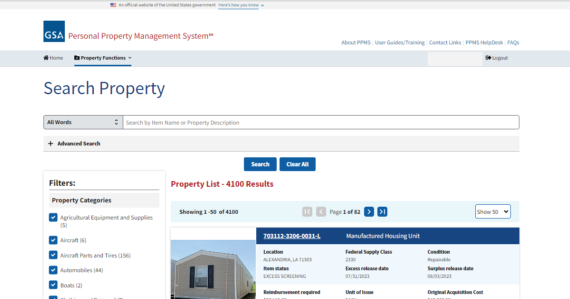
Everything must go: Giving federal surplus property a second chance
The U.S. General Services Administration (GSA) disposes of everything from office equipment, furniture and vehicles — trucks, planes, boats and more — to scientific devices, heavy machinery, and even luxury goods.
By offloading excess personal property through GSA’s Personal Property Management program, federal agencies reduce the federal environmental footprint through responsible waste management. This helps used government property avoid the landfill.
GSA recently combined seven websites into one to streamline its Personal Property Management System, making access to government auctions and property disposal faster, easier, smoother and more direct. Federal customers now have the convenience of using one system to manage and dispose of personal property, and all visitors can enjoy the upgrades of GSA Auctions and Computers for Learning sites for a more user-friendly experience.

“We take sustainability seriously,” said Federal Acquisition Service Commissioner Sonny Hashmi. “Keeping items that can be reused in service is one of our top priorities. By reusing and donating property we also save taxpayer dollars and ensure assets no longer needed at the Federal level continue to benefit communities across the country.”
Through GSA, the federal government has a pipeline that gives excess federal personal property the best chance of reuse.
How do we do it?
- Report it: When a federal agency determines it no longer needs an item, they report it as excess to GSA, who helps manage the disposal process.
- Offer it: GSA offers items for reuse within the federal government and select other entities, such as federally recognized tribes through other federal programs.
- Transfer it: GSA hosts the Computers for Learning website which enables federal agencies to offer computer equipment to schools and educational nonprofits serving K-12 students to promote technology in education.
- Donate it: GSA declares items not needed at the excess level “surplus.” They are then offered to eligible participants of the Federal Surplus Personal Property Donation Program, including state and local public agencies, certain non-profit organizations, and disadvantaged businesses. These recipients must apply for participation with their State Agency for Surplus Property.
- Sell it: GSA sells surplus property that is not donated on GSA Auctions to the general public alongside other categories of non-excess property, like exchange/sale vehicles.
“There is such a wide variety of items available — including furniture, aircraft, heavy equipment, and computers—that really could make a difference to the community, especially our most vulnerable groups,” said FAS General Services and Supplies Assistant Commissioner Erv Koehler. “It is extremely important that federal agencies and the public utilize the maximum benefits of these programs to avoid last resort decisions, like destruction.”
Surplus property not reused through these processes is recycled, destroyed, or formally abandoned by the government.
“Our goal is to make sure this property gets into the hands of those who have a sincere need,” Koehler said. “Therefore, if the system and the processes are confusing and clunky, then we could easily miss the opportunity to link federal agencies and the public with available surplus property. That’s why it was important to build a modern system that has intuitive and easy to use features.”
For more information
Federal agencies, check out GSA’s Personal Property Management System.
General public, explore GSA Auctions to buy federal surplus personal property.
State and local government agencies and non-profit organizations, visit www.gsa.gov/propertydonations for eligibility information.
Schools and educational nonprofits serving K-12 students, visit Computers for Learning.

 U.S. General Services Administration
U.S. General Services Administration
